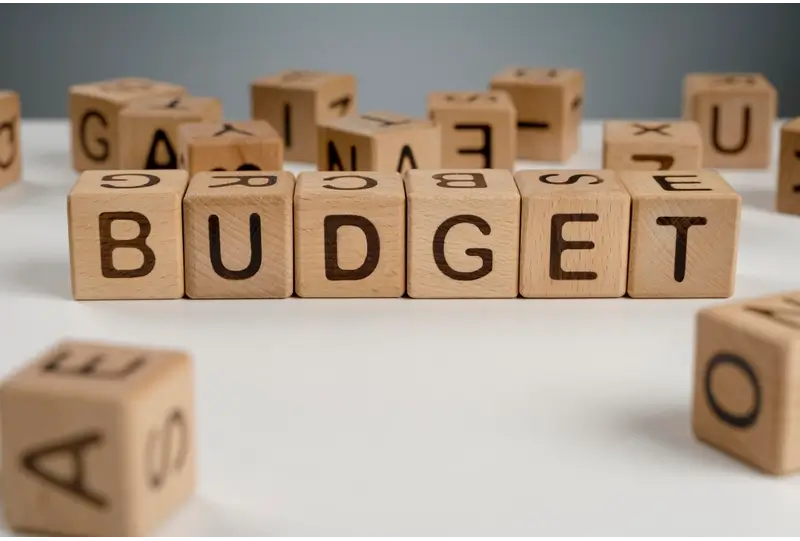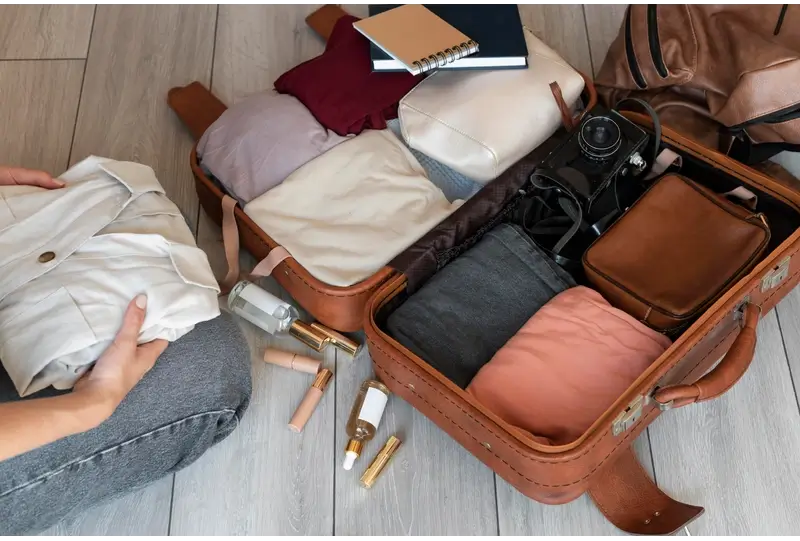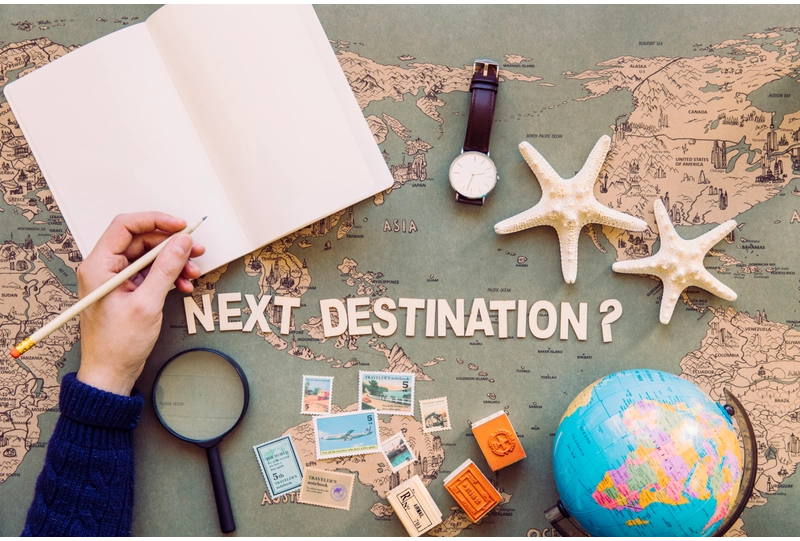Discover 7 simple steps to plan a trip like a pro. From budgeting to itinerary, master your travel planning for an unforgettable adventure!
Hey everyone, gather around. As someone who’s bounced around the globe more times than I can count, from hiking in the Rockies to sipping coffee in Paris cafes, I love chatting about trips over a beer or two. Today, I’m spilling my secrets on the 7 steps to plan a trip. It’s my go-to method that turns chaos into smooth sailing. Trust me, I’ve learned the hard way—forget one detail, and you’re scrambling at the airport. Let’s jump in so you can nail your next adventure without the headaches.
Step 1: Pick Your Dream Spot
First off, deciding where to go sets the tone for everything. I always start by brainstorming places that excite me. Think about what you crave—beaches, cities, or mountains? Last year, I eyed Iceland for its wild landscapes after seeing photos online.
Dig into research next. I scour blogs, watch YouTube vlogs, and flip through guidebooks. Check weather patterns and peak seasons too. For Iceland, I learned summer means midnight sun, perfect for road trips.
Consider any hurdles like visas or health rules. I once almost missed a Thailand trip over a forgotten visa stamp. Use government sites for updates. Chat with friends who’ve been there for real insights.
Weigh your group’s needs if traveling with others. Solo? Go wild. With family? Pick kid-friendly spots. This step keeps things realistic and fun.
Finally, narrow it down to one or two options. I make a pros-cons list. It helps avoid regret later.

Step 2: Nail Down Your Budget
Money talk comes early for me. Without a solid budget, trips can spiral out of control. I start by estimating total costs—flights, stays, food, activities. For a Europe jaunt, I budgeted $2,000 per person for two weeks.
Break it into categories. Flights might eat 30%, lodging 25%, meals 20%. Factor in extras like souvenirs or emergencies. I use apps like Mint to track this.
Look for ways to save. I hunt flight deals on sites like Skyscanner. Off-peak travel cuts costs big time. In Japan, going in shoulder season saved me hundreds.
Include hidden fees. Think currency exchange, tips, or transport. I always add a 10-15% buffer. It covers surprises without stress.
Review and adjust. If it’s too high, tweak—like swapping hotels for hostels. This keeps your plan grounded in reality.

Step 3: Lock in Dates and Duration
Timing is everything in travel. I pick dates based on work, school, or events. For a Bali escape, I chose May to dodge rain and crowds.
Consider how long you need. Short trips? 4-7 days. Longer explorations? 10-14. I match it to the destination—cities need less time than multi-country hops.
Check calendars for holidays or festivals. I timed a Mexico visit for Day of the Dead—unforgettable. But avoid peak times if you hate lines.
Factor in travel time. Jet lag from long flights? Add recovery days. For Australia, I built in a buffer after the 20-hour flight.
Confirm flexibility. Can you shift dates for cheaper fares? I use Google Flights’ calendar view for this. It shows price drops clearly.
Step 4: Book Your Way There
Getting there is half the battle. I start with flights, comparing options on multiple sites. For a South America trek, I snagged a deal by flying mid-week.
Don’t overlook other transport. Trains in Europe? Buses in Asia? I rode the bullet train in Japan—fast and scenic. Rent cars for remote spots, but check driving rules.
Book early for savings. I aim 2-3 months ahead for international. Use alerts for price drops. Once, I saved $200 on a NYC flight that way.
Consider layovers. Short ones save money, but long ones let you explore extras. I turned a Dubai stop into a quick city tour.
Double-check details. Baggage rules, seat selections, refunds. I print confirmations and add to my phone wallet. Peace of mind right there.

Step 5: Sort Out Where You’ll Crash
Accommodation makes or breaks comfort. I decide based on vibe—hotels for luxury, Airbnbs for homey feels. In Italy, a countryside villa beat any hotel.
Search platforms like Booking.com or Airbnb. Read reviews carefully. I filter for high ratings and recent feedback. Photos lie, but comments don’t.
Location matters. Central spots save time and transit cash. For Paris, I picked near the Seine—walked everywhere, skipped taxis.
Budget plays in. Hostels for solo budget trips, resorts for splurges. I mix it—fancy one night, basic others. Keeps things balanced.
Book with cancellation options. Life happens. I once canceled a Greece stay due to weather—no loss thanks to free cancel policy.
Step 6: Craft Your Daily Adventures
Now, the fun part—building your itinerary. I list must-sees first. For New Zealand, it was Hobbiton and fjords. Prioritize based on energy levels.
Use tools like Google Maps for routing. I plot days logically to avoid backtracking. Mornings for sights, afternoons for chill time.
Include downtime. Overpacking exhausts you. I slot in free hours for wandering or naps. In Spain, spontaneous tapas hunts were highlights.
Mix activities. Culture, food, nature. I research local eats and events. Apps like TripIt organize everything in one spot.
Share if group travel. I use shared docs for input. Ensures everyone enjoys. Adjust as needed—flexibility is key.
Step 7: Prep the Essentials and Go
Last push before takeoff. I handle docs first—passport, visas, insurance. Renewed my passport early for a Africa safari. Don’t wait.
Pack smart. Layers for weather changes, essentials only. I roll clothes to save space. For beach trips, sunscreen and hats top the list.
Health checks. Vaccines, meds, first aid. I pack copies of prescriptions. Travel insurance covers mishaps—saved me during a sprained ankle in hike.
Tech setup. Chargers, adapters, apps for translation. I download offline maps. Keeps me connected without roaming fees.
Final review. I go over everything a week out. Confirm bookings, check weather. Then, relax and excite for the journey.

Whew, that’s my take on the 7 steps to plan a trip. Each one builds on the last, turning ideas into reality. I’ve used this for solo jaunts and family getaways alike. Now, let’s dive deeper into why these work, with more tips I’ve picked up along the way.
Expanding on choosing your spot, I draw from countless chats with fellow wanderers. One buddy swore by mood boards—clipping images of dream places. It sparks joy. Another tip: consider sustainability. I opt for eco-friendly destinations to minimize impact. Research carbon footprints of flights too. For instance, shorter hauls emit less. This adds purpose to your choice.
In budgeting, I factor currency fluctuations. Apps like XE help track rates. I set aside for experiences over stuff—dinners beat trinkets. From forums, many suggest starting small: track daily spends at home, then scale up. It reveals habits. For groups, split costs via apps like Splitwise. No arguments over who paid what.
Dates wise, I avoid burnout by spacing trips. After a big one, I wait months. School holidays spike prices, so if kid-free, go off-term. Weather apps like AccuWeather give long-range forecasts. I once rescheduled a Patagonia hike due to predicted storms—smart move.
For bookings, multi-city flights open adventures. Fly into one city, out another. I did that in Southeast Asia—Bangkok in, Hanoi out. Saves backtracking. Loyalty programs rack points fast. I use Chase Sapphire for rewards. Check baggage—budget airlines nickel-and-dime extras.
Accommodations evolve with tech. VR tours on sites let you “walk” rooms. I love that. Host reviews matter—look for consistent praises. For unique stays, try glamping or houseboats. In Canada, a lakeside cabin was magic. Negotiate for longer stays; owners often cut deals.
Itineraries shine with themes. Foodie day, history day. I use Evernote for notes. Include backups—rainy day plans. From travel groups, many swear by walking tours first day to orient. Free ones abound. Pace yourself; jet lag hits hard.
Preps include mindset. I journal expectations to stay positive. Language basics via Duolingo help. Pack cubes organize luggage. Eco-tip: reusable water bottles cut plastic waste. Insurance? Get comprehensive—medical, cancellation. Sites like World Nomads cater to adventurers.
Blending these 7 steps to plan a trip has let me explore over 40 countries hassle-free. It’s not rigid; adapt to your style. Solo travelers might skip group input, families add kid activities. The key? Start early, stay organized.
Let’s talk tools. Beyond basics, AI planners like Wanderlog auto-suggest routes. I tried it for a U.S. road trip—mapped stops perfectly. Google My Maps for custom pins. Budget trackers like Trail Wallet log spends on the go.
Research depth varies. For off-beat spots, Reddit threads reveal gems. r/travel has gold. Books like Lonely Planet offer timeless advice. Podcasts too—”The Thoughtful Travel” inspires.
Group dynamics: Communicate early. I poll preferences via Doodle. Compromise keeps harmony. For couples, alternate picks—one day yours, one theirs.
Sustainability grows big. I choose trains over planes when possible. Support local—eat at mom-and-pops, not chains. Leave no trace in nature.
Challenges arise. Budget overruns? Cut non-essentials. Last-minute changes? Have backups. I pivoted a Europe plan when strikes hit—took buses instead.
Post-trip reflection helps. What worked? I note for next time. Builds better habits.
Now, for those burning questions.
Frequently Asked Questions
How far in advance should I start these 7 steps to plan a trip?
Aim for 3-6 months for international, 1-2 for domestic. Gives time for deals and prep.
What’s the biggest mistake in trip planning?
Overlooking budget buffers. Always add extra for surprises.
Do I need travel insurance?
Yes, especially abroad. Covers health, lost bags, cancellations.
How to plan for kids?
Include fun activities, pack snacks, choose family-friendly stays.
What if I’m on a tight budget?
Focus on free sights, public transport, hostels. Travel local.
Can apps replace manual planning?
They help, but personal touch ensures it fits you.
How to handle language barriers?
Apps like Google Translate, learn basics, or join tours.
What about solo travel safety?
Share itinerary, stay alert, use trusted apps for meets.
Wrapping It Up
There you have it, friends—my heartfelt guide on mastering trips. Following these steps turns wanderlust into action. I’ve shared from my journeys, hoping it sparks yours. Grab a map, dream big, and hit the road. Safe travels; can’t wait to hear your stories next hangout. Cheers!



